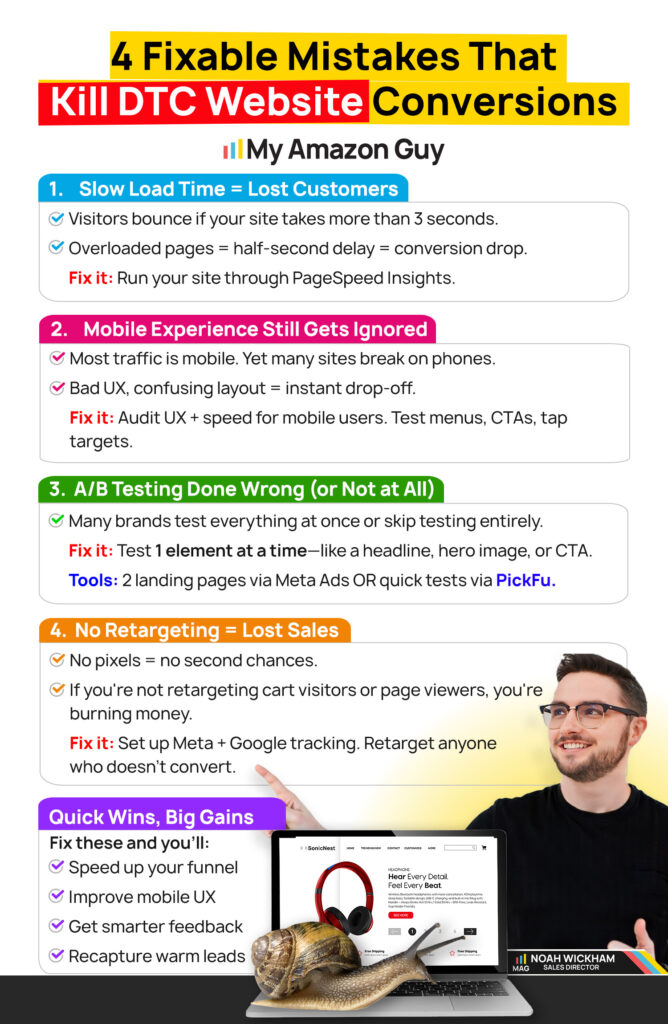Designing a DTC site can be exciting, especially when you have full control over the look and feel. You get the freedom to build something that reflects your brand’s personality, but the truth is that a pretty DTC website design is not enough to guarantee sales.
Some sellers, especially those expanding from Amazon into DTC, get carried away with the creative freedom. From choosing layouts and colors to customizing product pages, it’s easy to focus on design while forgetting what drives conversions.
The problem is that good web design without a sales strategy often results in a beautiful site that consumes time, money, and effort but fails to bring in customers. Without the right approach, all that hard work can leave you wondering why traffic isn’t translating into revenue.
In this guide, we’ll break down why good DTC website design isn’t enough on its own and how to pair it with strategies that actually drive sales. You’ll learn proven tactics like content optimization, mobile readiness, clear CTAs, competitive pricing, and continuous testing to turn visitors into buyers.
Table of Contents
Ready to Build a DTC Site That Sells?
Don’t settle for a pretty site that doesn’t convert. Let us help you create a high-performing store that drives real revenue.
The Role of Website Design in DTC Selling
Web design plays a huge role in DTC selling, with studies showing that 38% of people will stop engaging if they find a site unattractive. On top of that, 42% of consumers say they won’t buy from a website they consider ugly.
A well-designed site creates a strong first impression and builds trust with potential customers. It signals professionalism and quality, which can influence whether visitors feel confident enough to buy.
In DTC selling, design isn’t just about making a site look good, but about presenting products and information in a way that drives action. From appealing visuals to clear branding, every design choice can push customers closer to a purchase.
Why Pretty Website Design Is Not Enough
While a visually appealing website is very important, it’s not enough to guarantee success. The truth is: having a pretty DTC website alone won’t make you sell anything, and here’s why:
- Slow Load Times
High-resolution images, animations, and heavy design elements often slow down your site. If your page takes longer than three seconds to load, many visitors will leave before they even see your products. - Cognitive Overload
Overly flashy layouts with moving parts, bright colors, or excessive animations can overwhelm shoppers. When your design distracts from the buying decision, visitors bounce instead of browsing. - Unclear Messaging
A site can look impressive but still fail if it doesn’t clearly communicate what you sell and why it matters. If visitors can’t understand your value in seconds, they won’t stick around. - Hidden or Weak CTAs
Some designs bury calls-to-action in colors or styles that blend into the background. Without clear, action-driven CTAs, shoppers won’t know where to click or what step to take next. - Poor Mobile Experience
Over half of web traffic comes from mobile, but a design that looks great on desktop can break on smaller screens. If users have to zoom, scroll sideways, or fight misaligned elements, they’ll leave. - Lack of Strategic Focus
Even the most beautiful site is useless if it’s just a digital brochure. Without aligning design to business goals like sales or lead generation, you’re left with something nice to look at but not profitable.
From Amazon to DTC, We’ve Got You Covered
Our team helps Amazon sellers expand into DTC without the trial-and-error. Save time, skip costly mistakes, and launch with confidence.
Proven Conversion Strategies for DTC Sites
Since web design alone isn’t enough to drive sales, you need strategies that turn visitors into paying customers. Here are proven ways you can optimize your DTC site for better conversions and long-term growth.
1. Content Optimization
Content is the core of your DTC site since it’s what communicates your value, educates your audience, and builds trust. Well-written product descriptions, informative blog posts, and engaging videos help position your brand as a reliable source and keep visitors interested.
Pairing a good web design with great content can significantly boost your site’s ability to convert visitors into customers. When strong copy is supported by clean layouts, strategic formatting, and compelling visuals, your message becomes more engaging, easier to digest, and more persuasive.
2. Mobile Optimization
With 96% of internet users browsing on mobile devices, ignoring mobile optimization is like locking the door on most of your potential customers. A DTC website that isn’t mobile-friendly will struggle to convert, no matter how great the design is.
Mobile optimization ensures that your site is easy to navigate, loads quickly, and offers clear calls-to-action that work seamlessly on smaller screens. By making the buying process smooth and intuitive for smartphone users, you can boost conversion rates, improve search rankings, and keep shoppers from bouncing to competitors.
3. Market Research
Market research is the secret weapon behind high-converting DTC websites. When you know exactly who your audience is, what they want, and where they get stuck, you can design a site that speaks directly to them.
It’s not just about gathering data, but about turning that data into actionable changes that improve content, CTAs, navigation, and the overall buying journey. Done right, market research eliminates guesswork, giving you a clear roadmap to boost conversions and grow revenue.
4. High-Quality Product Image
High-quality product images are one of the most powerful tools you have to convert shoppers into buyers. Clear, professional visuals instantly build trust, making customers more confident about their purchase decision.
They also reduce uncertainty by showing products from multiple angles, highlighting details, and allowing zoom for a closer look. When shoppers know exactly what they’re getting, they’re far less likely to abandon their cart or return the product later.
5. Pricing Strategy
Pricing plays a big role in getting sales, especially when you’re in a niche with plenty of competing brands. A strong pricing strategy can be the deciding factor that convinces a shopper to choose your product over a competitor’s.
Did you know that 93% of online shoppers search for the lowest price before buying? That’s why it’s critical to research your market, understand your audience’s willingness to pay, and create a pricing model that balances profitability with competitive appeal.
6. Advertising Campaigns
A well-built DTC site won’t drive sales if nobody visits it. That’s why advertising campaigns often matter more for revenue than web design, because they’re the engine that brings in the right audience and turns clicks into customers.
From paid search and social ads to influencer partnerships, advertising lets you target the exact demographics and interests most likely to buy your products. It boosts visibility, drives high-intent traffic, and delivers measurable results that can be optimized over time for maximum ROI.
7. Brand Building
For DTC sites, brand building often plays a bigger role in driving long-term sales than a sleek-looking website. A strong brand creates trust, communicates reliability, and makes customers feel confident about choosing your products over someone else’s.
Brand identity also sets you apart in crowded markets, telling customers exactly why you’re the better choice. When your brand connects on an emotional level, it turns one-time buyers into loyal advocates who keep coming back and bring others with them.
8. Personalization
Personalization drives performance and better customer outcomes, and the fastest-growing companies earn 40% more of their revenue from it compared to slower-growing competitors. In the DTC space, it’s not just a “nice to have”; it’s the difference between being remembered or forgotten.
When you tailor product recommendations, offers, and content to match a shopper’s behavior, location, and preferences, you make it easier for them to buy. From curated homepages and relevant suggestions to cart-abandonment triggers with time-sensitive deals, personalization keeps customers engaged, builds loyalty, and moves them from first-time buyers to repeat customers.
9. Testing for User Experience
What use is a pretty DTC website if customers can’t even figure out how to buy from it? That’s exactly why UX testing is so important since it ensures shoppers can find what they need, understand your products, and check out without headaches.
Regular testing identifies frustrating bottlenecks, from clunky navigation to a checkout process that makes customers want to give up. By fixing these pain points, you boost engagement, reduce cart abandonment, and make it far more likely that visitors turn into repeat buyers.
10. Quick Loading Speed
The first 10 seconds of a visit can decide whether a shopper stays or clicks away. If your site loads slowly because of heavy visuals or overdone design elements, you’re practically handing sales to your competitors.
Even a one-second delay can slash conversion rates and frustrate visitors into leaving. For DTC brands, optimizing for speed means more people actually see your products, browse your catalog, and make it to checkout.
11. Customer Reviews and Testimonials
One of the strongest pushes a customer can get to buy a product comes from reviews and testimonials. In fact, 92% of shoppers hesitate to purchase when there are no reviews, no matter how nice the site looks.
That’s why having a system to gather reviews from satisfied buyers is essential. By showcasing authentic feedback front and center, you build trust, crush doubts, and give customers the nudge they need to click “Buy”.
12. Analyze and Modify
A DTC website isn’t “done” just because it looks great and works today. Even the best design should be revisited regularly by using analytics tools to track which areas keep customers engaged and which cause them to bounce.
By studying this data, you can fine-tune your strategy, design, and content for better results. Continuous analysis and small, targeted tweaks ensure your site keeps converting at its highest potential.
FAQs About DTC Website Design
What is a DTC website?
A DTC website is an online store where a brand sells its products directly to customers without going through third-party retailers or marketplaces.
Is DTC a good business model?
Yes, DTC can be highly profitable because it gives brands full control over pricing, branding, and customer relationships while cutting out middleman costs.
Should I hire a DTC web design agency?
If you want a site that converts visitors into customers, hiring a DTC web design agency can save time, avoid costly mistakes, and ensure your site is built for sales, not just looks.
Good Web Design: A Starting Point, Not a Finish Line
When Amazon sellers move on to selling through their own DTC site, they gain a new level of freedom to design their store exactly how they want. They can control the branding, the visuals, and the overall feel, which is something you can’t do on Amazon’s platform.
However, good web design alone won’t convert customers. You still need the right strategies, from optimized product pages to social proof and consistent testing, to turn visitors into buyers.
Are you looking for an agency that can help you with more than just Amazon? Reach out to our full-service Amazon agency; we don’t just grow your Amazon sales, we also help you build high-converting DTC websites that sell.
Your DTC Site Should Work as Hard as You Do
We combine web design, strategy, and marketing to help your site perform. The result? More clicks, more sales, and more repeat buyers.





